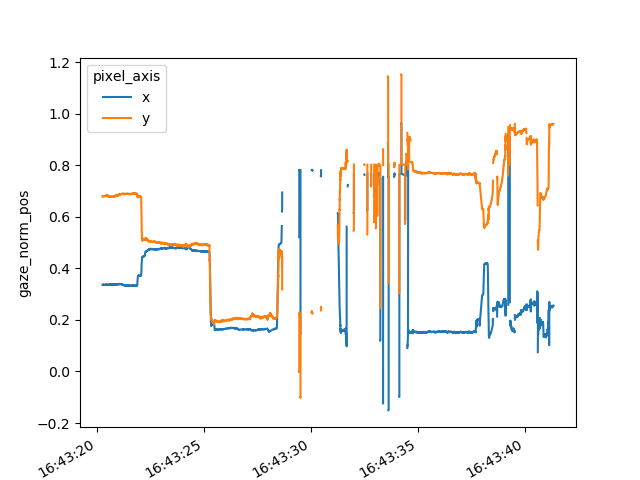Note
Click here to download the full example code
Gaze mapping pipeline
This example shows how to perform post-hoc pupil detection, calibration marker detection, calibration and gaze mapping.
Note
This example requires the dependencies for
pupil detection as well as
matplotlib.
import pupil_recording_interface as pri
Set recording folder
folder = pri.get_test_recording()
Out:
Downloading file 'branch-v2.0.zip' from 'https://github.com/vedb/pupil-example-data/archive/refs/heads/branch-v2.0.zip' to '/home/runner/.cache/pupil-example-data'.
Unzipping contents of '/home/runner/.cache/pupil-example-data/branch-v2.0.zip' to '/home/runner/.cache/pupil-example-data/branch-v2.0.zip.unzip'
Create readers for video streams
world_reader = pri.VideoReader(folder)
eye0_reader = pri.VideoReader(folder, stream="eye0", color_format="gray")
eye1_reader = pri.VideoReader(folder, stream="eye1", color_format="gray")
Detect pupils
pupil_detector_eye0 = pri.PupilDetector(camera_id=0)
pupil_list_eye0 = pupil_detector_eye0.batch_run(eye0_reader)
pupil_detector_eye1 = pri.PupilDetector(camera_id=1)
pupil_list_eye1 = pupil_detector_eye1.batch_run(eye1_reader)
Detect calibration markers
marker_detector = pri.CircleDetector()
marker_list = marker_detector.batch_run(world_reader)
Merge pupil data and run calibration
calibration = pri.Calibration(resolution=world_reader.resolution)
pupil_list = pri.merge_pupils(pupil_list_eye0, pupil_list_eye1)
calibration_result = calibration.batch_run(pupil_list, marker_list)
Map gaze as dataset
gaze_mapper = pri.GazeMapper(calibration=calibration_result)
gaze = gaze_mapper.batch_run(
pupil_list, return_type="dataset", info=world_reader.info
)
Plot gaze
norm_pos = gaze.gaze_norm_pos.where(gaze.gaze_confidence_2d > 0.7)
norm_pos.plot.line(x="time")

Out:
[<matplotlib.lines.Line2D object at 0x7fc7d5b13828>, <matplotlib.lines.Line2D object at 0x7fc7d5ac8cf8>]
Total running time of the script: ( 0 minutes 21.196 seconds)